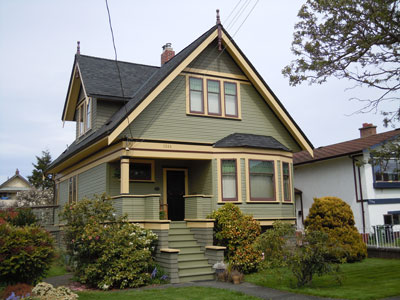Heritage Register
Fairfield
1244 Chapman Street
Built
1912-13
Heritage-Designated 1991
For: Thomas Thompson

ARCHITECTURE:
This house is a good example of the 1½-storey Edwardian Vernacular Arts & Crafts middle-class dwellings built at the height of the boom period in the expanding suburb of Fairfield. It has the typical features of steep front-gabled roof with fairly large gabled dormers on each side (all gables have finials and drop finials), asymetrical main floor on front and symmetrical upper floor (except for the hipped roof of the bay), inset corner front porch balanced by the projecting cantilevered bay, and the strong horizontals of belt course at the base of the main floor, double wide string course at its top, and a smaller string course above the gable windows. Many of the windows are double hung sash, protected by newer wooden storm windows, and there are two piano windows, on the front porch and the S side. There is a bank of four windows on the S side. The main siding is double-bevelled, with cedar shingles on the ground level and in the peaks of the gables. By the 1970s the porch was enclosed and the solid, stepped stair balustrade was replaced with railings. In 1993, owners Sheilagh Walsh and Peter Walton won a Hallmark Society Award for their restoration of this house, including the stairs and porch.
ORIGINAL OCCUPANTS:
This revenue property was built for Thomas John Thompson (1852-1936), a retired farmer. Born in Yorkshire, England, Thomas came to Canada c.1878, lived in Ontario for some time, and then moved to Alberta, where he lived for 25 years. He came to Victoria in about 1911 with his children and wife Janet. They lived at 1018 Oliphant for many years.
The first known resident of this house was John A. MacKenzie, who lived here in 1913-14. He was a branch manager of Canadian Consolidated Rubber Co.
OTHER OCCUPANTS:
In 1915-16 this was the residence of architect Percy Fox (1877-1939) and his wife Edith Victoria, who were born in Bradford, Yorkshire, England, and came to Victoria in 1911. Percy trained in Bradford, and opened his own architectural office there in 1900. In Victoria he worked first for architect Thomas Hooper, then went into private practice in 1912. In 1913 he entered into partnership with Ralph Berrill, who left to fight in Europe soon after the outbreak of WWI in 1914. Fox designed several stores for David Spencer, 1000-12 Douglas for Otto Weiler, the Bessborough Apartments at 906 McClure St, a number of handsome Tudor Revival-style apartment blocks for John Moxam, including the Harrogate Apartments at 1203 Beach Dr in Oak Bay, and a number of houses. Percy was highly regarded in the architectural profession and served as president of the AIBC in 1927-29.
The Foxes later moved to Howe St, where Edith, who suffered a lingering illness, hung herself in 1926. Percy, a devotee of thoroughbred horse racing, was for a time managing director of Colwood and Willows Park race tracks. In the 1930s he was involved in the gold mining boom on Vancouver Island’s west coast, including the Privateer Mine and settlement of Zeballos. In his last year he ran Kennedy Lake Gold Mines.*
The Wright family lived here 1917-24. The family emigrated from England in 1908. Alexander Wright, a butcher, enlisted with the CEF in 1916. It is likely that he was killed overseas, as his wife Susan was listed by herself in City Directories in this house until 1924, although in the 1911 census they had two children, John and Lizzie.
The MacKinnon family bought this house by 1929 and lived here for the next 30 years. Donald MacKinnon (1892-1985) was a long-time clerk with the BCCSS. He and his wife Jean Campbell (McConnell, 1893-1986) were natives of Glasgow, Scotland.
* Research by Jennifer Barr & Mary Doody Jones for Building the West, 2003.

